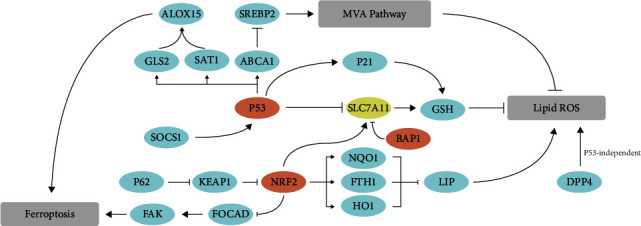Figure 4.

The role of transcription factors in ferroptosis. p53 has a dual function in the control of ferroptosis. On the one hand, p53 can promote ferroptosis via repression SLC7A11 expression or through promoting SAT1 and GLS2 expression, thus activating ALOX15 to induce lipid peroxidation and ferroptosis. On the other hand, the antiferroptotic function of p53 is that p53 can transcriptionally inhibit DPP4 expression or induction of p21 expression. NRF2 can negatively control ferroptosis sensitivity by activating SLC7A11 transcription, inhibiting cytosolic accumulation of labile iron pool, or repressing FOCAD expression, thus promoting tumor cells resistant to ferroptosis. ALOX15: arachidonate lipoxygenase 15; SREBP2: sterol regulatory element-binding transcription factor 2; GLS2: glutaminase 2; SAT1: spermidine/spermine N1-acetyltransferase 1; ABCA1: ATP-binding cassette subfamily A member 1; P21: also known as CDKN1A: cyclin-dependent kinase inhibitor 1A; SOCS1: suppressor of cytokine signaling 1; p63: tumor protein p63; KEAP1: Kelch-like ECH-associated protein 1; NQO1: NAD(P)H quinone dehydrogenase 1; FTH1: ferritin heavy chain 1; HO-1: also known as HMOX1: heme oxygenase 1; FOCAD: focadhesin; FAK: also known as PTK2: protein tyrosine kinase 2.
